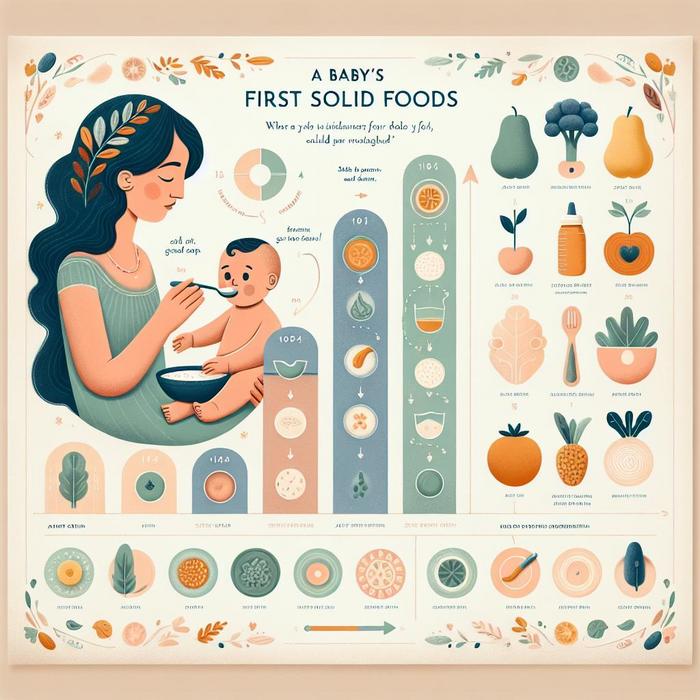Introducing Solids: The First Step in Your Baby’s Nutritional Journey
Introducing solids is a major milestone in your baby’s life. This step holds great significance as it sets the tone for your child’s future relationship with food. But, when should you introduce solids? What kind of foods should you start with? If you’re anxious or uncertain, don’t worry. This comprehensive guide will equip you with all the knowledge you need to make your baby’s transition to solids easy and enjoyable.
When to Start Your Baby on Solids
According to the Centers for Disease Control and Prevention, the ideal age to start introducing solids to your baby’s diet is around six months. However, it’s important to remember that every baby is unique and develops at their own pace. Here are some signs that your baby might be ready to try solid foods:
- They can support their own head and sit upright without support.
- They show interest in your food.
- They have lost the tongue-thrust reflex that pushes food out of the mouth.
If your baby exhibits these signs, it might be the right time to start introducing solids as part of their diet. However, if you’re unsure, always seek advice from a healthcare professional.
Choosing the Right Baby First Foods
Introducing solids marks the start of an exciting new phase. Your baby gets to explore different flavors and textures, which can be a thrilling experience for both of you! But, with a plethora of baby first foods to choose from, deciding where to start can be challenging. The Mayo Clinic recommends starting with single grain cereals and then gradually introducing fruits, vegetables, and meats. Following a structured approach can help you monitor your baby’s reaction to each new food, making it easier to identify any potential food allergies or sensitivities.
- Rice or oat cereals: These are often recommended as the first solid foods because they are easy to digest and are rarely allergenic. Plus, they can be mixed with breast milk or formula to make the transition easier for your baby.
- Fruits and vegetables: Pureed fruits and vegetables like apples, bananas, carrots, or sweet potatoes can be introduced after cereals as they are packed with essential vitamins and minerals.
- Meats and proteins: Pureed meats, beans, or yogurt can be introduced as your baby becomes more accustomed to solid foods. These foods are an excellent source of protein and iron, which are vital for your baby’s development.
While introducing solids, it’s essential to follow a ‘4-day wait’ rule. This means introducing a new food every four days to watch out for any adverse reactions or allergies.
Methods of Introducing Solids to Your Baby
When it comes to introducing solids, there is no ‘one-size-fits-all’ approach. Some parents prefer traditional spoon-feeding, while others opt for the baby-led weaning method. According to this NPR article, both methods have their pros and cons, and it ultimately depends on what works best for you and your baby.
The Baby-Led Weaning Method
Baby-led weaning is a method where babies control their solid food consumption by “self-feeding” right from the start. It encourages the baby to explore and enjoy a variety of foods at their own pace. More information on the baby-led weaning method can be found on the What To Expect website.
- Baby-led weaning allows your baby to set the pace and choose what they eat from the food you offer.
- It encourages independence, boosts coordination, and lets your baby enjoy an array of textures and tastes.
- However, risks include choking and inadequate nutrient consumption, especially if not properly supervised.
The Traditional Spoon-Feeding Method
The traditional method of introducing solids is through spoon-feeding, where you as a parent control the feeding pace. More information about spoon-feeding can be found on the American Academy of Pediatrics’ website.
- You can introduce different tastes and textures gradually.
- It’s easier to ensure that your baby gets the right amount of nutrients.
- However, it may not encourage chewing skills or independence as much as baby-led weaning.
Best Practices for Introducing Solids
The process of introducing solids should be gradual and carefully monitored. Here are some tips to ensure a smooth transition, per insights from BabyCenter:
- Begin with small portions to avoid overwhelming your baby.
- Stick to a regular feeding schedule to help your baby adjust.
- Be patient and encourage your baby to explore new foods at their own pace.
Monitoring Your Baby’s Reaction to Solids
It’s crucial to monitor your baby’s reactions when introducing new foods. Signs of food allergies can include rash, vomiting, or diarrhea. It’s also important to look for signs of choking or difficulty swallowing. Always consult a healthcare provider if you suspect any adverse reactions.
Final Thoughts
Introducing solids is an important milestone in your baby’s life. It’s essential to take a gradual, patience-focused approach, taking the time to monitor your baby’s reactions to each new food. You can explore more about introducing solids from this helpful SolidStarts resource. Ultimately, you know your child best and should trust your instincts when making decisions about their nutritional journey.

